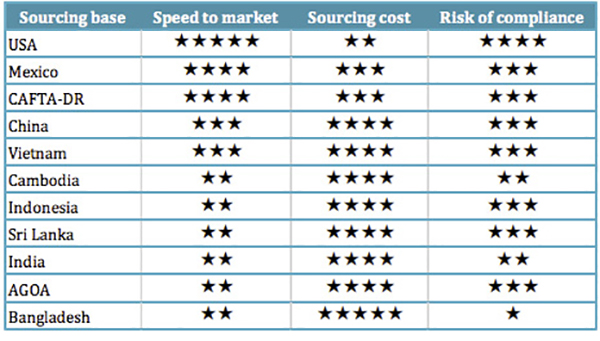Fashion Supply Chain: What to Where
While most fashion and apparel executives are optimistic about the 5-year outlook for the industry, the percentage fell from 92.3 percent in 2016 to 71 percent in 2017, a record low for the United States Fashion Industry Association’s annual Fashion Industry Benchmarking Study, which surveyed executives from leading fashion and apparel brands, retailers, importers, and wholesalers.
The rise of new challenges for the industry—specifically, the "protectionist trade policy agenda in the United States," which executives rank as their top challenge in 2017, up from being ranked the #10 challenge last year—could explain the decline.
Among the key survey results:
- Executives are more concerned about trade protectionism, market competition from e-commerce, and supply chain risk than they are about cost. "Increasing production or sourcing cost" dropped from the #2 concern in 2016 to the #7 concern in 2017.
- Only 36 percent of executives surveyed say they expect to increase sourcing from Vietnam, compared to 56 percent in 2016. This is most likely due to the United States’ withdrawal from the Trans-Pacific Partnership.
- Among all sourcing destinations examined in 2017, Bangladesh is considered the most competitive in terms of price—but also the riskiest in terms of trade compliance (see chart above).
- Free trade agreements remain underutilized; only NAFTA is utilized by more than 50 percent of companies surveyed.
- Ethical sourcing and sustainability are given more weight in sourcing decisions, with 87.5 percent saying these issues have become more important in sourcing decisions today versus five years ago; 100 percent of companies surveyed audit their suppliers.
- It’s unanimous: 100 percent of respondents oppose the U.S. border adjustment tax (BAT) proposal.
The survey was conducted in conjunction with Dr. Sheng Lu, assistant professor at the University of Delaware Department of Fashion & Apparel Studies.
Sourcing: A Mixed Bag
Survey respondents rated each primary sourcing destination against three criteria with the most significant impact on sourcing decisions. Overall, no destination is perfect. The results, however, explain why U.S. fashion companies typically use a mix of sourcing destinations to balance cost, speed, flexibility, and risk control.
Note: The results were based on respondents’ average rating for each sourcing base. ***** means much higher performance than the average and * means much lower performance than the average.

